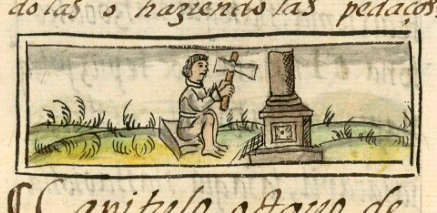tlatecqui (FCbk10f16v)
This iconographic example, featuring a lapidary or stone worker (tlatecqui), is included in this digital collection for the purpose of making comparisons with related hieroglyphs. The term selected for this example comes from the text near the image in the Digital Florentine Codex. There is no gloss, per se. This example shows a profile view of a man facing right. He is seated on a box (perhaps meant to be an icpalli woven seat, but it does not appear woven). He holds an ax with two cutting edges. This metal head has been slipped over the end of a wooden pole and attached to it in some way. This is a Nahua artisan, but he is dressed in trousers and a long-sleeve shirt with ruffles at the wrists and neck–a style adopted by the Spanish colonizers. He is working on a stone column with an elaborate, multilayered base that includes a facade with a flower or sun design that is a quincunx shape.
Stephanie Wood
See another tlatecqui from the Codex Mendoza, below. That one is working on precious stone beads. Some examples of other hatchets, axes, or adzes also appear below. The earliest examples of these tools usually had copper (tepoztli) heads, but Europeans introduced other metals. Often, these tools were simply called tepoztli. A person who used an ax or hatchet for cutting or shaving might also be a texinqui. A mason could be called a tetzotzonqui. A carpenter could be called a cuauhxinqui. There are many possibilities. The design on this columnar base might be called a cuilolli (painting) as seen below.
Stephanie Wood
tlatecgui
tlatecqui
Stephanie Wood
1577
Jeff Haskett-Wood
arquitectura, labrar, martillar, esculpir, pulir, piedras, artesano, toltecatl, hacha, martillo de cantero, azuela, tlaquetzalli, temimilli, columna, pilar
tlatecqui, one who cuts, typically stones, often precious stones, a lapidary, https://nahuatl.wired-humanities.org/content/tlatecqui
el lapidario
Stephanie Wood
Available at Digital Florentine Codex/Códice Florentino Digital, edited by Kim N. Richter and Alicia Maria Houtrouw, "Book 10: The People", fol. 16v, Getty Research Institute, 2023. https://florentinecodex.getty.edu/en/book/10/folio/16v/images/0 Accessed 5 September 2025.
Images of the digitized Florentine Codex are made available under the following Creative Commons license: CC BY-NC-ND (Attribution-NonCommercial-NoDerivs 4.0 International). For print-publication quality photos, please contact the Biblioteca Medicea Laurenziana ([email protected]). The Library of Congress has also published this manuscript, using the images of the World Digital Library copy. “The Library of Congress is unaware of any copyright or other restrictions in the World Digital Library Collection. Absent any such restrictions, these materials are free to use and reuse.”







